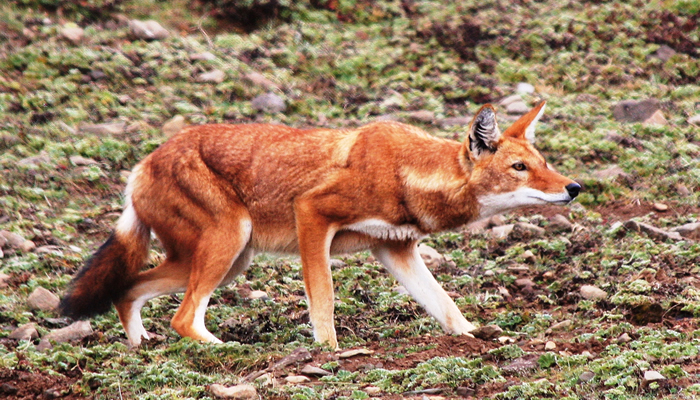Covering an area of 2200 km2 Bale Mountains National Park is the largest remaining alpine habitat on the African continent. Founded in 1970, the Park contains the biggest continuous area of Afro-alpine vegetation (~1000 km2, circa 17.5% of all Afro-alpine vegetation) and a large proportion of moist tropical forest.
Bale Mountains National Park offers opportunities for unsurpassed mountain walking, horse trekking, scenic driving and chances to view many of Ethiopia's endemic mammals, in particular Ethiopian Wolves, Simien Foxes, Menelik's Bushbucks and Mountain Nyalas.
 Birds such as the Thick-billed Raven, Wattled Ibis, Blue-winged Goose, Rouget's Rail, etc. can easily be seen in the Park. Bale is the southern-most breeding population of Golden Eagles, Wattled Cranes and has a large breeding population of Bearded Vultures. The wetlands and forests of Bale are the source of major rivers which provide a significant proportion of the perennial water supply to approximately 10 million people in South-eastern Ethiopia and Somalia.
Birds such as the Thick-billed Raven, Wattled Ibis, Blue-winged Goose, Rouget's Rail, etc. can easily be seen in the Park. Bale is the southern-most breeding population of Golden Eagles, Wattled Cranes and has a large breeding population of Bearded Vultures. The wetlands and forests of Bale are the source of major rivers which provide a significant proportion of the perennial water supply to approximately 10 million people in South-eastern Ethiopia and Somalia.
Trekking Possibilities
Trekking can be arranged starting from Dinsho or from Dodola, a relatively new trekking area. Dinsho, the parks headquarters, lies in a grassy riverine plain bordered by St. John's Worth bushes. Wild flowers, such as lobelia, geraniums and Red-hot Pokers form a colorful carpet during spring.
The trek takes you over the Senetti Plateau, crossing Batu Mountain and to the highest peak of the Bale Mountains, Tullu Deemtu (4377 m). En the route you will find small alpine lakes, streams full of trout and typical afro-alpine vegetation like Giant Lobelias and Everlasting shrubs. Most of the campsites lie between 5 and 18 km apart and are situated over 3000 m, where temperatures get colder and night frosts are frequent. The trek ends on the road to Goba, where we meet the vehicles. This all-weather road crosses the loveliest mountainside at 4000 m altitude before it descends through heather moorlands followed by beautiful Hagenia forests.
Refer to Trekking Bale Mountains National Park


